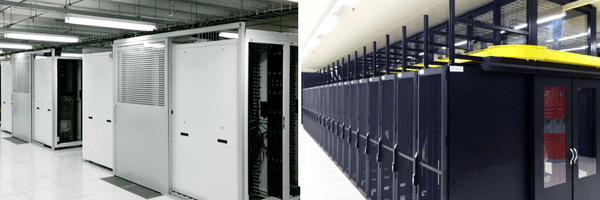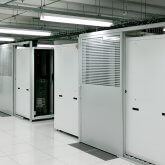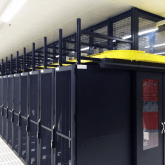Your Guide to Data Cooling Systems
Whatever the size or type of your data centre, it is important to obtain a suitable cooling infrastructure that can supply enough ventilation necessary to keep all devices within a desired temperature range. With the copious amount of heat that IT equipment can produce and the concerns for rapidly increasing energy consumption, there is an ever-present problem to achieve maximum efficiency in data centres.

Data centre cooling refers to the regular monitoring of temperatures, consumption data and equipment performance, however there are more permanent and durable solutions that can contribute towards regulating the desired temperature range.
Cross-Guard has provided many types of solutions for data centre cooling that can help to benefit both the environment and your bank account. With popular systems such as cold air containment (CAC) and hot aisle containment (HAC) creating solid barriers for the separation of cold and hot air, there is also the rise in popularity of liquid cooling solutions – but which one is best for you?
Cold Aisle Containment (CAC)
 Cold aisle containment is an airflow management system that can restrict the loss of cold air, by preventing the mixing of cold and hot air. This system is set up by lining up server and network cabinets in alternating rows, with cold air intakes and hot air exhausts facing opposite directions.
Cold aisle containment is an airflow management system that can restrict the loss of cold air, by preventing the mixing of cold and hot air. This system is set up by lining up server and network cabinets in alternating rows, with cold air intakes and hot air exhausts facing opposite directions.
The benefits of cold aisle containment include:
- Improving energy efficiency up to 30% relative to no CACS
- Easier to retrofit, reducing cost and difficulty of adding system to pre-existing infrastructures
- Functions best in raised floor environments, meaning it does not require the special return ductwork other systems may need
- Ability to direct contained cold air to specific equipment, giving greater overall control to data centre managers
Hot Aisle Containment (HAC)
Hot aisle containment has gained increasing popularity as denser computing and power loads have evolved. This system works by ensuring the hot exhaust air from the racks is contained within the aisle, enabling the rest of the data centre to become a large reservoir of cold air. Typically the hot air is ducted away, either via a plenum space in the ceiling, or using large ducts connected to the CRAH unit.
One popular alternative to this approach is known as in-row cooling, where CRAC units are built into the cabinet rows. The hot aisle will then typically look identical to a  cold aisle with a flat aisle roof, and there is no requirement for a hot air plenum.
cold aisle with a flat aisle roof, and there is no requirement for a hot air plenum.
The benefits of hot air aisle containment include:
- Ability to set working temperature to 24°C
- In-Row Cooling is Closed Couple Cooling – short air paths and low air pressure resistance – uses a lower power consumption by fans
- More free cooling days available with HACS leading to significant saving in electrical cost
- Methodology allows for channelling of hottest air directly into coolers for most efficient cooling speed.
Liquid Cooling Systems
Liquid cooling is a growing trend for data centre engineers for use within high-density applications and high-performance computing. A liquid-based cooling system involves chillers that remove heat to the outside environment, often with the assistance of a cooling tower, to provide cool water. This liquid is then transported to the data centre, where it can be channelled to the specific areas of the server that produces heat.
Whilst liquid cooling can include benefits such as maximising energy efficiency, lower operating costs and increased rack utilisation, there are reasons as to why this application has not become a default option:
- Any maintenance, changing of cables or other activity involving contact with the servers also requires contact with the liquid. A spill can create a hazard for both the employees and the servers.
- A large supply of liquid is required to support the infrastructure
- Retrofitting liquid cooling systems to an existing data centre can prove to be costly at the installation stage
With liquid cooling systems still facing a number of hurdles before it can be used throughout all types of data centres and facilities, hot aisle and cold aisle containments have proven to be most popular and versatile for changing requirements. By implementing a data cooling system that can be modified to your data centre needs, such as HACs and CACs, it can improve your IT equipment life, carbon footprint and favourable return on investment (ROI).
For more information on data centre cooling and how Cross-Guard can help you to achieve data centre efficiency, please contact us via sales@cross-guard.com or 01992 442 449 to speak to a member of our expert sales team.
SHARE
DOWNLOAD A COPY OF OUR BROCHURE

GET A QUOTE
Get a Quote Form
"*" indicates required fields
